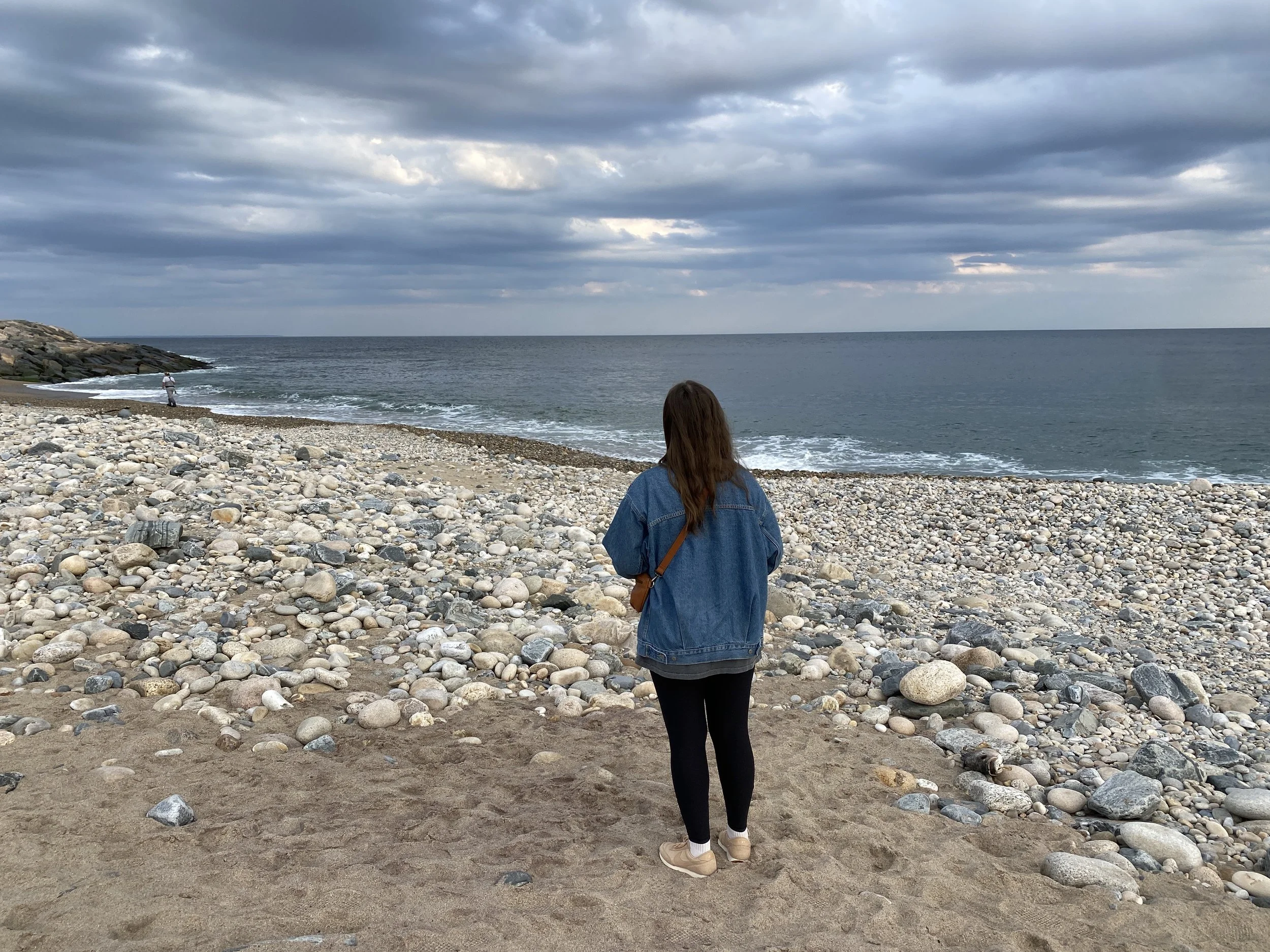Reduce your carbon footprint with a spending freeze.
three ways to cut your carbon footprint.
1. Stop flying.
2. Stop eating meat.
3. Stop buying into fast-fashion.
I decided to start with fast-fashion. I'm giving up buying clothes and home-goods, or any non-essential items for 40 days. My goals are to become more mindful about my consumption habits, reduce my carbon footprint, and bring more awareness to the impact of overconsumption. Or really, the over-consumption of all types of fashion. Because if we keep buying and disposing of sustainably-made clothing at the same rate we’ve been doing with non-sustainably made clothing aka fast-fashion, we will still have a problem.
The problem is overconsumption.
If you haven’t had a chance to watch the documentary film, True Cost, you need to. You’ll be utterly disgusted with the current system in which we buy our clothes and wonder how we let it happen. For starters, ‘The clothing industry is the second-largest polluter in the world, second only to the oil industry.’ (Washington Post, 2016) And it’s not just about how the clothing is made, it’s how we care for it, and how we dispose of it.
So March 1, I stopped buying. My goal is to combine my shopping hiatus with a refocusing of personal development goals, so by April 10, I won’t have anything I want to buy. And if I do, I’ll know that it will be an item that will be in my closet for years to come.
I also didn’t want my buying freeze to end up becoming a fad diet, where for 40 days I’m excessively strict and then I end-up going back to retail therapy, binge browsing, and obsessing over all of the beautifully curated items popping up on my computer. (I’m pointing at you Reformation, Nisolo, Zady, and Cuyuna.)
Instead, I’m looking for a lifestyle change.
Changing habits are hard and overcoming the social pressures of fast-fashion can be a huge challenge. So far, I’ve found that my shopping fast is much more difficult when I’m constantly being bombarded with targeted ads. Especially, when it’s specific items I casually browsed a few weeks ago and they had been out-of-sight, out-of-mind since.
This should not be super surprising, because its estimated in a single day, a person who lives in the city, is exposed to up to 5,000 messages a day. Thirty years ago it was just 2,000. (NYT, 2007).
The impact of this constant barrage of advertisements brought up a few questions. Why do we consume? And when we do, are we really thinking for ourselves — being mindful about our personal goals, likes and dislikes, and aspirations for the future? Or are we being sucked into a whirl-wind of what’s “cool” what’s “in” and what’s going to make us “prettier”, “smarter”, “sexier”?
Why we consume.
I started doing a little more research on the topic of consumption and found that sustainable development research expert, Dr. Gill Seyfang breaks the theoretical approaches to consumer motivation into three basic methods; Utilitarian, Social and Psychological, and Infrastructures of Provision. (Seyfang, 2009:8)
(The) utilitarian approach to consumption, belonging within the traditional neo-classical economics, which examines the behavior of rational individuals in markets. The second looks at social-psychological drivers of consumption such as status display, group membership, and cultural norms, similarly at the scale of individual consumers. The third takes a societal perspective, and studies the socio-technical infrastructure and systems. (Seyfang, 2009:8-9)
Basically, we consume because we need it or (the main issue) because it makes us feel good and/or connected in some way. Her research goes on to explain that we often suffer form what’s called the ‘value-action gap’, which shows that educated consumers do not always make choices that align with their stated values. (Seyfang, 2009:11)
Exactly.
That’s why many of the men and women I know who are educated on the impact of fast-fashion and overconsumption have yet to make a meaningful change in their personal lives. We need to change this.
Currently, an American woman adds an average of 64 pieces of new clothing to her wardrobe each year. In 1930, she only had 9 outfits altogether.’ (Overdressed: The Shockingly High Cost of Cheap Fashion, 2012) In addition,
On average each American throws away roughly 70 pounds of clothing and other textiles per year, equivalent in weight to more than 200 men’s T-shirts. (Huffington Post, 2013)
I’m no different. After reading that stat, I went through my closet and counted at least 25 new items that had been added within the past year. And I’m an advocate for change! But as I reminded myself, that’s part of the reason I’m giving up buying anything non-essential for 40 days. I know bad-habits are hard to break.
Currently, I’m almost 10 days into the no-shopping journey and I can’t say that I’ve been the best at keeping away from online browsing.
For example, swimsuits. I love the idea of getting a new swimsuit because my summer goal is to spend a ton of time kayaking and swimming in the lakes around our house. More moments, fewer mementos, right? So, the idea that buying a new swimsuit is somehow going to make me go to the lake and swim and kayak more often is absurd. I doubt I will actually have happier memories or look cuter participating in these future adventures by buying a new swimsuit. But somehow that’s exactly the feeling that I get when I see the ads.
I also drooled over some Reformation dresses thinking about how fun it would be to wear them to a few weddings we have this spring/summer/fall. I was mentally rationalizing their purchase, because they’ve been sustainably and/or ethically made. And it probably helps that the women all look amazing — so sexy, powerful, and beautiful. I could be that too, if only I had that dress.
Flash to reality. The weddings that I’m headed to this spring/summer/fall don’t really call for a long, silky backless dress. I’m all for creating my own personal style, but if showed up in it, I probably wouldn’t feel myself, and wouldn’t be able to help tear down chairs at the end of the night. And then there’s the tie-limbo, one of my husband’s favorite moves to pull out at the end of any wedding dance. I probably wouldn’t be able to participate in that either, if I was wearing that dress. And I like the limbo!
So. I closed the computer and went through my closet Konmari style. I touched every item. I thought about my goal to live more sustainably, to refocus my life on living intentionally and asked myself if any of these items sparked joy. Lucky for me, they did! So why wouldn’t I wear them again? I had at least four options that would fulfill the outfits I needed.
But then this insane idea popped into my head. I started to think that maybe I could just buy a cheap dress from H&M, Target, keep it for a long time and I’d still have something new to wear for the wedding. Thank you constant advertisments. Obviously, this is exactly what i’m trying to avoid, but it’s crazy how quickly it seemed a viable option.
Intention and distraction are key.
Here’s what I’ve noticed. Focusing on your intention and distracting yourself seem to be the keys to successfully implementing a buying freeze.
If I’m really aware about my mood and the marketing tactics that are being used by the advertisement, I can better separate myself from the emotional draw of consumption and re-focus on my long-term goal, which is living more sustainable. If I didn’t have this intention to go back to, I think it would be easy to end-up buying things I don’t need and feel guilty about it later.
The second thing I’ve noticed is that distraction can be helpful. While focusing on your intention helps you to think more clearly about why you’re not going to buy something, it’s even more helpful to have a healthy diversion.
By refocusing my attention to something that is more experience-based, like going for a bike ride with friends, practicing my ukulele, or planning an overnight kayak trip, I have less room in my life for browsing, which helps me focus on my goal of living more sustainably.
We don't need new clothing to look beautiful.
'The beauty of a woman is not in the clothes she wears, the figure that she carries, or the way she combs her hair. The beauty of a woman is seen in her eyes, because that is the doorway to her heart, the place where love resides. True beauty in a woman is reflected in her soul. It’s the caring that she lovingly gives, the passion that she shows and the beauty of a woman only grows with passing years.
Audrey Hepburn










